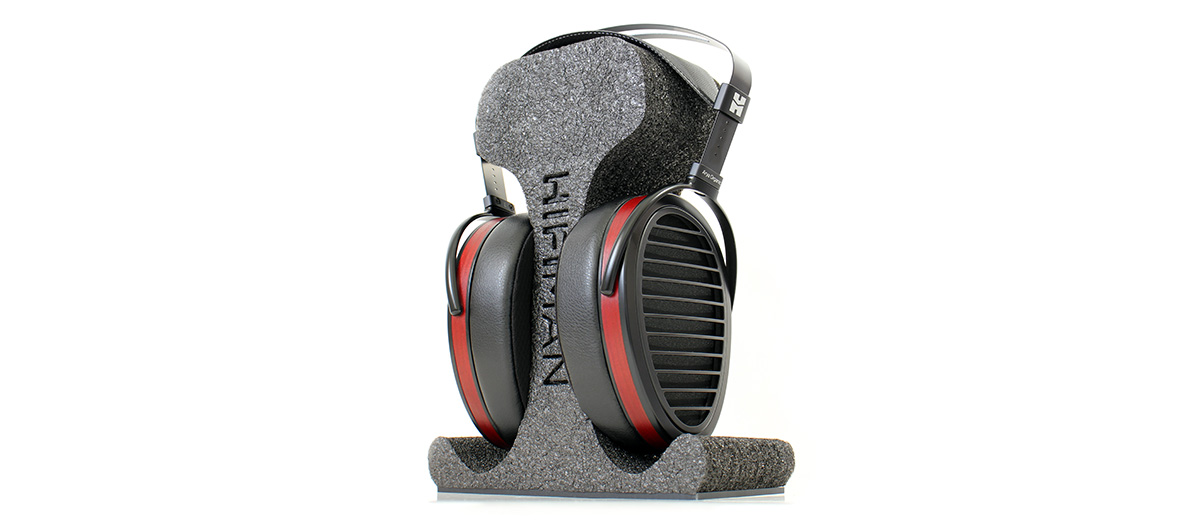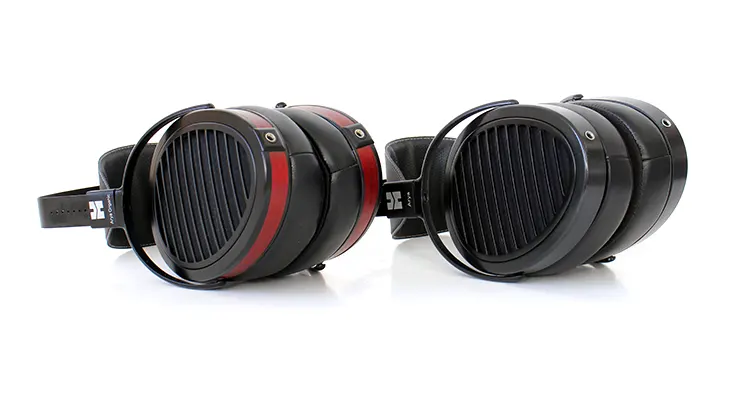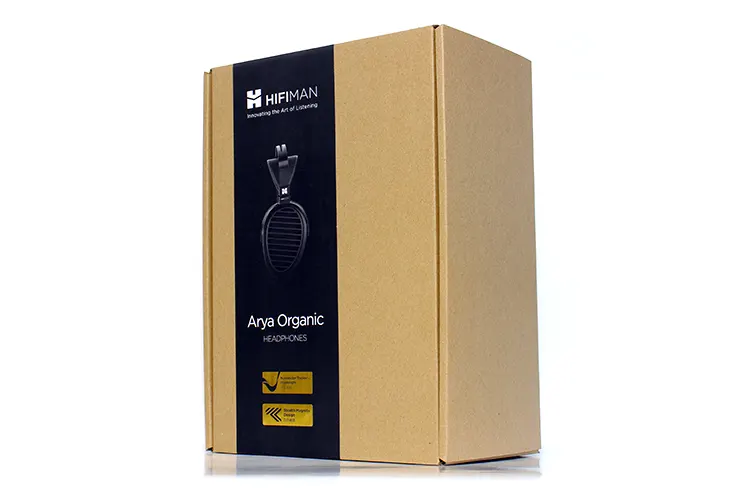Synergy
Efficiency
Believe it or not, this reviewer keeps a pair of Phillips SHP9500 headphones on my desk most of the time. They’re my throw-around and beat-up cans. They sound decent since they’re well broken in. They are also highly efficient and ultra-comfortable but if they break on me I will not be stunned.
I mention them because many readers are familiar with them and know you can power them with a whisper. Believe it or not, I find the SHP9500 headphones to be just as efficient as the Arya Organic.
Perhaps you’ll lose a decibel or two at the same volume level over the SHP9500 but that in itself should tell you that we have a highly efficient driver here that does not require high power to operate well.
There is an obvious upscale in quality as you improve the DAC and amplifier setup feeding them especially if you drive them with high-current capable amplification.
Pairings
Since the HIFIMAN Arya Organic is an efficient planar, more so than others, sources were scattered to include the EF400 and the EF600, an iFi Audio iDSD Diablo, plus an iFi Audio NEO iDSD but since HIFIMAN only includes 6.35mm connectivity it limited me to use some similarly equipped gear.
So unless you have another cable or are willing to obtain one you’re limited to desktop use and can’t use a DAP, a dongle DAC, or anything similar out of the box because they just do not have 6.35mm connectivity onboard.
So I dug into the HIFIMAN Audivina box and grabbed the XLR balanced cable to see if there was scalability here and they certainly upscale with better amplification. A perfect example would be to say that they work best with the EF600 versus the EF400, in fact.
Select Comparisons
HIFIMAN Arya (V2)
Technical
There’s not much to say if we compare the Arya Organic with the previous Stealth Magnet revision. I can say that some attention was put on the Arya Organic around the upper midrange to reduce harshness in that area but it’s a minimal correction and most might not perceive it.
But version 2 is a different animal altogether. It uses what HIFIMAN calls a window shade system that attempts to assimilate what the Stealth Magnet implementation does. Both attempt to reduce refractions on the output side of the driver, in a nutshell.
The implementation on V2 was accomplished by using smaller magnets on the output side. The Stealth Magnet design takes it a step further, reshapes the magnets, and rounds the edges so that soundwaves have less to bump into leaving the driver.
Even though a good amount of efficiency was squeezed out of the V2 drivers the Arya Organic is much more efficient. Power output on most amplifiers usually tends to max out with a 32Ω load and the V2 has a 35Ω impedance which is closer to that spec but the 90 dB rating is lower than the 16Ω Arya Organic rating that specs out at 94dB.
One could say that the Arya Organic seems more efficient than its rated spec but the V2 is the opposite in that it requires more raw power and current to be driven properly and the specs could lead one to believe that they don’t require ample power.
Design
There’s not much difference between these two. Build-wise, the only visual cue is the contrasted blackout design of version 2 which if not for the attractive window shade grille, there wouldn’t be much to excite the visual senses.
They look slick but the Arya Organic model took the title of the best-looking Arya build to date. The cups are a few millimeters thicker but it seems that’s part of the tuning as stated in that it allowed HIFIMAN to push the driver further away from the ear giving you that seal-breaking effect that increases bass response, common with HIFIMAN headphones.
Performance
The most obvious difference here is the size of the soundstage and the additional focus the Arya Organic displays in placement, plus an additional dose of bass grunt. The V2 sounds larger but they also widen each instrument or element’s focal point and aura size.
Each component within a recording takes up a larger space on the Arya V2 and the components are painted in a larger size but they lose that dynamic characteristic found within the Arya Organic’s sound signature.
The bass response seems to have a deeper reach capability in the bottom region on the V2 but the bass response seems tighter, faster, and has more weight and body on the Arya Organic variant. I do prefer the Arya Organic’s bass response over all the other Arya variants hands down.
The mids seem spacious and seem further back on the V2 and there are a couple of peaks that can get one’s attention that are not present on the Arya Organic variant.
So although there seems to be more forwardness in the Arya Organic sound signature, the midrange frequencies feel less stressed compared to the V2. The highs are also improved with an increase in true tone character.
HIFIMAN Audivina
Technical
The questions to be asked here are the following. Do you need a closed back with better isolation and do you prefer a studio monitor tuning? That’s the HIFIMAN’s Audivina pitch but I disagree with one of those statements and feel these are too much fun to be called studio monitors.
HIFIMAN took a very different approach and broke their norm with the Audivina by using a redesigned driver that seems comparatively smaller than all of their Asymmetrical cup-equipped lineup drivers used.
From the least expensive edition XS to the 1000se, they all use the extra large 160mm driver diaphragm but at least the Audivina kept the Asymmetrical cup design. They just used a smaller, redesigned driver.
Design
Speaking of cup design, boy are these Audivina wooden cups massive. They’re also gorgeous but I wouldn’t wear them outside because one would stick out like a sore thumb.
The overall headband quality is improved and it borrows construction similarities from the HE1000 series. Instead of a cloth and plastic-coated head strap like the Arya lineup uses, the Audivina steps it up a notch by using a thicker cowhide material, but I would still use a cover or a wrap regardless.
The Audivina color scheme was borrowed from the DEVA line but it keeps the HE1000 construction aspect that I like, more so because it’s adjustable while wearing and seems more comfortable to wear over the DEVA headband style comparatively.
Performance
The Audivina seems more concentrated on detail extraction. Plus they attempt to assimilate an open-back design by producing a wide soundstage, larger and beyond most closed-back designed can’s capabilities.
But they seem to have a neutral character overall while the Arya Organic has a forward characteristic that might come across as colored if you do a side-by-side comparison.
It is an amazing fact however that the HIFIMAN Audivina can compete and produce a soundstage size that is comparable to the Arya Organic but not the version 2 of course which produces a larger one in scope.
There is one area that the Arya Organic wins in and that’s in overall tonality and fun factor since I can detect a slight hollow aspect and I hear it particularly with drum snares on the Audivina, not so much with other mid-centric sounds.
The Arya Organic has a slight edge in efficiency over the Audivina as well. Not that the Audivina needs big power to get them going but both do benefit from high current amplification, especially the Arya Organic.
Our Verdict
On rare occasions, things get better and less costly, that seems to be a rule in life but the HIFIMAN Arya Organic broke that rule. They offer an improved and refined sound profile overall and improved looks but cost less than its predecessor.
How can something like this emerge on the market? Simple, practice, and as they say, practice makes perfect. This is the path HIFIMAN has taken and they’re further improving. If they can improve on connectivity and quality of the cable and pads later on, I would have nothing to protest about in future reviews.
But as it stands, the HIFIMAN Arya Organic goes into the recommended list because even though you might be bound to outsource another cable, they still offer improvements over the past iterations and regardless, the extra cable cost will still keep you well under the original posted retail.
HIFIMAN Arya Organic Technical Specifications
- Frequency Response: 8Hz to 65kHz
- Impedance: 16 ohms
- Sensitivity: 94db
- Weight: 440g






